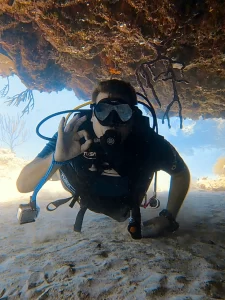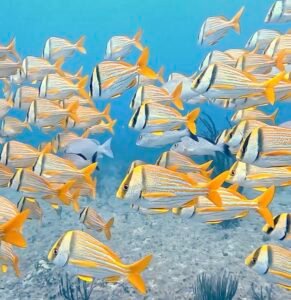Welcome, fellow diving enthusiasts! Whether you’re an experienced diver or just dipping your toes into the underwater world, understanding the language of scuba diving is essential for a safe and enjoyable experience. Welcome to the ABCs of Diving, where we will explore different scuba diving terms as we go through the alphabet. To read previous posts from this column check out our other blogs. Today we continue with the letter M:

Macro Photography: Macro Photography in diving refers to the technique of capturing close-up images of small marine life and underwater details. Using specialized lenses and equipment, divers can photograph tiny creatures and intricate underwater landscapes with remarkable detail. This type of photography is particularly popular among those interested in documenting the smaller, often overlooked, aspects of the underwater world.
Mask: A Mask is a fundamental piece of diving equipment designed to help divers see clearly underwater. It consists of a rigid frame with a transparent lens and a silicone skirt that seals around the diver’s face. The mask creates an air pocket in front of the eyes, allowing for clear vision and preventing water from entering the eyes and nose.
Mask Squeeze: Mask Squeeze occurs when the pressure inside the mask is lower than the surrounding water pressure. This often happens when a diver descends and the air inside the mask compresses, creating a vacuum that pulls on the face and can cause discomfort or bruising. To avoid mask squeeze, divers should equalize the pressure inside the mask by exhaling gently through the nose.
Mixed Gas: Mixed Gas refers to the use of gas mixtures other than standard air for breathing underwater. Divers use different gas mixtures to optimize their dive profiles and reduce the risks of nitrogen narcosis and oxygen toxicity. Common mixed gases include Nitrox (oxygen and nitrogen) and Trimix (oxygen, nitrogen, and helium), each offering different advantages for various depths and dive conditions.
Monofin: A Monofin is a type of fin that is worn as a single, large fin rather than two separate fins. It is designed for efficiency in propulsion and is often used in freediving and competitive swimming. By using a monofin, divers can achieve greater speed and efficiency in the water, making it a popular choice for those looking to enhance their diving performance.
Multilevel Diving: Multilevel Diving is a diving strategy that involves exploring different depths during a single dive. This technique allows divers to extend their bottom time and experience various underwater environments while managing their nitrogen absorption and decompression limits. Multilevel diving requires careful planning and monitoring to ensure safe ascent rates and decompression stops.
Scuba diving is a blend of technical skill, environmental awareness, and appreciation for marine life. By familiarizing yourself with these diving terms, you’ll enhance your diving knowledge and safety practices, ensuring each underwater adventure is a memorable and enjoyable experience. Whether you’re exploring reefs, wrecks, or underwater caves, the underwater world awaits with its mysteries and beauty. Happy diving!


